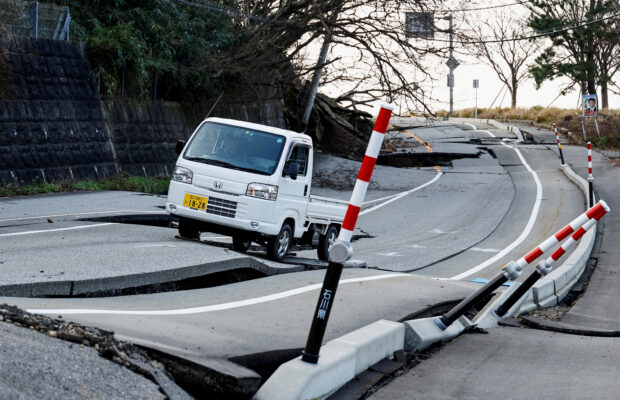
Masatoshi Nakamae drives his car on a damaged road as he heads to his town Soryomachi, which is isolated after the earthquake, in Wajima, Ishikawa Prefecture, Japan, January 6, 2024. (REUTERS)
WAJIMA, Japan – The confirmed death toll from the New Year’s Day earthquake in Japan reached 110 on Saturday as a search for survivors in the rubble of collapsed buildings entered a sixth day.
The magnitude 7.6 quake struck the west coast, destroying infrastructure and snapping power links to 22,000 homes in the Hokuriku region. Rain hampered efforts to sift the rubble for survivors as more than 30,000 evacuees awaited aid.
The number of confirmed dead was 110 by 4 p.m. (0700 GMT) on Saturday, up from 94 the previous day, the Ishikawa government website showed. More than 200 people are still missing after the deadliest quake in nearly eight years.
“I am keenly aware of the extent of the damage caused,” Prime Minister Fumio Kishida said as the toll crossed 100.
The figure is the highest since a toll of 276 in quakes in 2016 in the southwestern region of Kumamoto, a tally that includes related deaths.
Kishida told government officials to speed up emergency efforts to restore trunk roads ripped up by the quake so that rescue and relief activities can be increased.
Japan’s Self-Defense Forces is set to reinforce the number of rescue staff by 400 to 5,400, with road disruptions among the obstacles hindering delivery of relief supplies.
Mudslides, boulders and road cracks left dozens of remote communities in Ishikawa prefecture isolated. In Wajima’s Fukamimachi district, helicopters from the Self-Defense Forces airlifted at least 14 residents to safety, according to a Reuters witness.
Freelance cameraman Masao Mochizuki, 73, stood in a long queue outside a supermarket in the regional city of Wajima after it re-opened on Thursday, waiting to buy necessities.
“It is such a help that they have managed to re-open,” Mochizuki told Reuters after buying a box of heat patches, blue plastic sheets to cover broken windows and a pair of shoes to protect against glass shards that litter the floors of his home.
“But I don’t see the road to reconstruction just yet,” Mochizuki added, his voice cracking with emotion.
SLEEPING IN CARS
While the displaced have packed Wajima’s evacuation centers for food, water and other basics, some residents are opting to sleep in their cars.
The Jan. 1 quakes destroyed the wooden home of Yutaka Obayashi, 75, and wife Akiko, 73. But after a night spent in a makeshift evacuation spot in a community centre, they decided to go home and sleep in their tiny passenger vehicle.
“People’s eyes make me very nervous,” Obayashi told Reuters, as his wife took a rest in a reclined seat in their car. “I just don’t like living with many people around me.”
Weather officials warned of the chance of heavy snowfall in the region from late Sunday through early Monday, which could trigger secondary disasters, such as landslides.
Seismic rumbles continue, with an earthquake of intensity 5 on Japan’s seismic scale in the town of Anamizu early on Saturday.
Ayuko Noto, a priest at Wajima’s Juzo shrine, whose history dates back 1,300 years, has also chosen to sleep in his car along with family members, even though their house withstood the quakes. That way they hope to protect themselves from further major quakes and possible tsunami waves.
“Aftershocks are still continuing,” said Noto, 47. “We are choosing our car over our house so we can flee right away in case another major one strikes.”
Asked how long they would continue doing that, she replied: “I just don’t have an answer to that.”